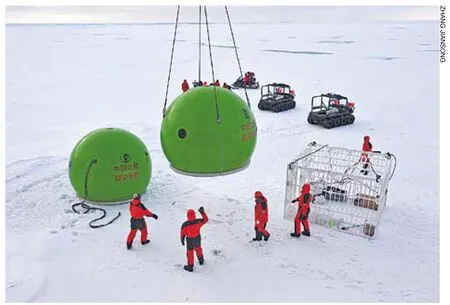Testing The Ice
2010-03-15YULINTAO
The country’s fourth scientific expedition to the North Pole starts

OBSERVATION STATIONS:Members of China’s fourth Arctic expedition set up polar bear-proof“apple houses” on the ice surface of the Arctic Ocean on August 8
By YU LINTAO
The Chinese icebreaker Xuelong(Snow Dragon) left the port of Xiamen, southeast China’s Fujian Province, on July 1, beginning an 85-day journey to the Arctic. This was China’s fourth voyage to the region following the 1999, 2003 and 2008 expeditions and also the longest.
Objectives
The expedition has two main objectives∶observe the rapid changes of sea ice in the Arctic area and the impact the changes are having on the Arctic’s marine ecosystem.Scientists are to observe factors associated with extensive melting of sea ice, and will make a comprehensive study of the ecological systems of the region from multiple perspectives. The areas of the scienti fi c exploration include the Bering Sea and Strait,the Chukchi and Beaufort Seas, the Canada Basin and the Mendeleev Sea Ridge.
The Arctic region is one of the most sensitive areas to climate change, and what was happening in the area was closely related to global climate and environment change,said Wu Jun, head of the expedition, who is also Deputy Director of the Polar Region Exploration Office of the State Oceanic Administration of China. “The melting of Arctic sea ice directly affects people’s lives and has touched the nerves of scientists worldwide.”
Monitoring during the last 30 years shows the climate and environment of the Arctic are changing rapidly. The sea ice of the Arctic Ocean in summer decreases gradually, which causes changes in climate and ecological environment, placing the region squarely in the forefront of a global climate change study.
China, a country in the Northern Hemisphere, was affected directly, rapidly and profoundly by the changes of Arctic climate and environment, said Yu Xingguang, chief scientist of China’s fourth Arctic expedition.The first three scienti fi c explorations of China to the Arctic Ocean region made a preliminary study of the climate and environment change mechanism of the area, and obtained valuable scienti fi c data and samples.
The expedition this time consists of 122 people, including scientists from more than 20 scienti fi c research units, logistical staff, the media and Xuelong crew from the mainland and Taiwan. Seven of the scientists come from the United States, France, Finland,Estonia and South Korea.
Troubles and threats
Arctic sea ice could cause unpredictable threats to the expedition, said Shen Quan,Captain of Xuelong. “Particularly in summer, the temperature is high, and melting can be very severe. It will bring great trouble to our operations and threaten the safety of the ship,” he said. Shen is a veteran of scienti fi c explorations and has already sailed to the Antarctic on 10 occasions.
The expedition will set up a number of short-term and long-term observation stations on the ice surface of the Arctic Ocean,to study the velocity of the ice’s melting and obtain related data.
A long-term station should operate for 15-20 days. It needs a large, complete section of ice for personnel and equipment to stay,and even for a helicopter to land. If there is severe melting, it becomes very hard to fi nd suitable observation sites. If they can’t be found, the expedition has to change plans and head farther north.
Another big risk for the expedition comes from polar bears. As the ice melts, the habitat and food chain of polar bears change and the bears are more likely to move into zones of polar exploration.
“From previous experiences, chances of meeting polar bears are increasing all the time. It is a big threat to us,” said Shen. Polar bears are almost totally white, so it is dif fi cult to make them out. Previously, expeditions have used helicopters to drive them away, and have also fi red guns to warn the bears off. The expeditioners have also been given specialized training to ward off any threat posed by polar bears. An American scientist who lived in Alaska for eight years was invited to be the training guide.
Huang Wenfeng, a member of the exploration team, said the expedition had been fully prepared. They took along several reinforced fiberglass “apple houses” for observation stations instead of putting up tents as they had done previously. The houses have been designed with holes to observe the sea ice and they provide a degree of protection against polar bears as well.
During the 85-day expedition, there is no need for any material resupply.
Xuelong has equipped with two normal container-size, vacuum fresh preservation storage units. This is the first time these devices have been used in China’s polar exploration.
Zhu Juyin, a team member in charge of logistics, said the storages could keep green vegetables fresh for at least two months.
There was not much difference in living conditions and menus between Arctic and Antarctic expeditions, so the explorers would have no difficulty in living conditions, Zhu said. ■
